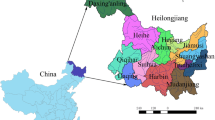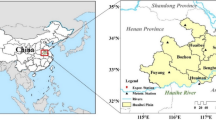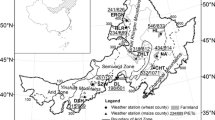Abstract
Drought is a common occurrence in Nebraska and agriculture is the primary economic sector affected. Because of repeated and widespread severe drought impacts, more emphasis on drought risk management is warranted. This study develops an agricultural drought risk assessment model using multivariate techniques. The model is specific to corn and soybeans and is able to assess real-time agricultural drought risk associated with crop yield losses at critical phenological stages prior to and during the growing season. The assessment results are presented in a Geographic Information System to provide a better visualization. This model provides information in a timely manner about potential agricultural drought risks on dryland crop yield to decision makers ranging from agricultural producers to policy makers from local to national levels.
Similar content being viewed by others
References
Agriculture Atlas of Nebraska: 1977, University of Nebraska Press, 110 pp.
Camargo, M. B. P. and Hubbard, K. G.: 1999, Drought sensitivity indices for a Sorghum Crop, Journal of Production Agriculture 12(2), 312–316.
CARC, Climate Assessment and Response Committee: 2002, http://carc.nrc.state.ne.us/carcunl/.
CCC, Colorado Climate Center: 2003, http://ccc.atmos.colostate.edu/standardizedprecipitation.shtml.
da Mota, F. S.: 1983, Weather-technology models for corn and soybean in the south of Brazil, Agricultural Meteorology 28, 49–64.
de Jager, J. M., Potgieter, A. B., and van den Berg, W. J.: 1998, Framework for forecasting the extent and severity of drought in maize in the Free State Province of South Africa, Agricultural Systems 57, 351–365.
de Jager, J. M., Howard, M. D., and Fouche, H. J.: 2000, Computing drought severity and forecasting its future impact on grazing in a GIS, In: D. A. Wilhite (ed.), Drought: A Global Assessment, Chap. 20, Routledge, London, pp. 269–278.
Denmead, O. T. and Shaw, R. H.: 1960, The effects of soil moisture stress at different stages of growth on the development and yield of corn, Agronomy Journal 52, 272–274.
Dennett, M. D., Elston, J., and Diego Q, R.: 1980, Weather and yields of tobacco, sugar beet and wheat in Europe, Agricultural Meteorology 21, 249–263.
Dietz, T. J., Put, M., and Subbiah, S.: 1998, Drought risk assessment for dryland agriculture in semi-arid Telangana, Andhra Pradesh, India, In: H. J. Bruins (ed.) The Arid Frontier: Interactive Management of Environment and Development, Chap. 8, Kluwer Academic Publishers, Dordrecht, Netherlands, pp. 143–161.
Duchon, C. E.: 1986, Corn yield prediction using climatology, Journal of Climate and Applied Meteorology 25, 581–590.
Easterling W. E., Warren, S. A. P., Guinan, P., and Shafer, M.: 1988, Improving the detection of agricultural drought: A case study of Illinois corn production, Agricultural and Forest Meteorology 43, 37–47.
Edwards, D. C. and McKee, T. B.: 1997, Characteristics of 20th century drought in the United States at multiple time scales, Atmospheric Science Paper No. 634, May, 1–30.
Germain, R. J.: 1996, Drought management using a geographical information system, M.S. Thesis, College of Engineering and Technology, Ohio University.
Hayes, M., Wilhite, D. A., Svoboda, M., and Vanyarkho, O.: 1999, Monitoring the 1996 Drought using the standardized precipitation index, Bulletin of the American Meteorological Society 80(3), 429–438.
Hayes, M., Svoboda, M., and Wilhite, D. A.: 2000, Monitoring drought using the standardized precipitation index, In: D. A. Wilhite (ed.), Drought: A Global Assessment, Chap.1. Routledge, London, pp. 168–180.
HPRCC, High Plains Regional Climate Center: 2002, http://hprcc.unl.edu/.
Hill, R. W., Johnson, D. R., and Ryan, K. H.: 1979, A model for predicting soybean yields from climate data, Agronomy Journal 71, 251–256.
IANR, Institute of Agriculture and Natural Resources, University of Nebraska – Lincoln, 2003. http://ianrnews.unl.edu/static/0301162.shtml.
Johnson, R. A. and Wichern, D. W.: 1998, Applied Multivariate Statistical Analysis, 4th Edition. Prentice Hall, Upper Saddle River, New Jersey, 81 pp.
Kulshreshtha, S. N. and Klein, K. K.: 1989, Agricultural drought impact evaluation model: A systems approach, Agricultural System 30, 81–96.
Kumar, V. and Panu, U.: 1997, Predictive assessment of severity of agricultural droughts based on agro-climatic factors, Journal of the American Water Resources Association 33(6), 1255–1264.
Lourens, U. W. and de Jager, J. M.: 1997, A computerized crop-specific drought monitoring system: Design concepts and initial testing, Agricultural System 53, 303–315.
Luo, H., Skees, J. R., and Marchant, M. A.: 1994, Weather information and the potential for intertemporal adverse selection in crop insurance, Review of Agricultural Economics 16(3), 441–451.
McKee, T. B., Doesken, N. J., and Kleist, J.: 1993, The relationship of drought frequency and duration to time scales, Proceedings of the Eighth Conference on Applied Climatology, Boston: American Meteorological Society, pp. 179–184.
Meyer, S. J., Hubbard, K. G., and Wilhite, D. A.: 1993a, A crop-specific drought index for corn: I. Model development and validation, Agronomy Journal 86, 388–395.
Meyer, S. J., Hubbard, K. G., and Wilhite, D. A.: 1993b, A crop-specific drought index for corn: II. Application in drought monitoring and assessment, Agronomy Journal 86, 396–399.
Meyer, S. J. and Hubbard, K. G.: 1995, Extending the crop-specific drought index to soybean, 9th Conference on Applied Climatology, American Meteorological Society, pp. 258–259.
Mjelde, J. W. and Penson Jr., J. B.: 2000, Dynamic aspects of the impact of the use of perfect climate forecasts in the corn belt region, Journal of Applied Meteorology 39, 67–79.
NASS, USDA, U. S. Department of Agriculture: 2003, http://www.usda.gov/nass/.
NDMC, National Drought Mitigation Center: 2003, http://www.drought.unl.edu/monitor/spi.htm.
NDMC/NOAA/USDA Drought Monitor: 2003, http://www.drought.unl.edu/dm/monitor.html.
Nullet, D. and Giambelluca, T. W.: 1988, Risk analysis of seasonal agricultural drought on Low Pacific Islands, Agricultural and Forest Meteorology 42(2–3), 229–239.
Pitter, R. L.: 1977, The effect of weather and technology on wheat yields in Oregon, Agricultural Meteorology 18, 115–131.
Pochop, L. O., Cornia, R. L., and Becker, C. F.: 1975, Prediction of winter wheat yield from shortterm weather factors, Agronomy Journal 67, 4–7.
Redmond, K. T.: 2002, The depiction of drought: A Commentary, The Bulletin of the American Meteorological Society 83(8), 1143–1147.
Reibsame, W. E., Changnon, Jr., S. A., and Karl, T. R.: 1991, Drought and Natural Resources Management in the United States: Impacts and Implications of the 1987–89 Drought, Westview Press, Boulder, Colorado, 174 pp.
The State of Nebraska Drought Mitigation and Response Plan: 2002, http://carc.nrc.state.ne.us/carcunl/docs/planning.html.
Sundt, N.: 2002, Agriculture and climate change: A hard row to hoe, http://www.globalchange.org/featall/2000winter2.htm
Starr, T. B. and Kostrow, P. I.: 1978, The response of spring wheat yield to anomalous climate sequences in the United States, Journal of Applied Meteorology 17(8), 1101–1115.
Svoboda, M., LeComte, D., Hayes, M., Heim, R., Gleason, K., Angel, J., Rippry, B., Tinker, R., Palecki, M., Stooksbury, D., Miskus, D., and Stephens, S.: 2002, The drought monitor, The Bulletin of the American Meteorological Society 83(8), 1181–1190.
Thompson, D. and Powell, R.: 1998, Exceptional circumstances provisional in Australia — is there too much emphasis on drought? Agricultural Systems 57(3), 469–488.
Thompson, D. R. and Wehmanen, O. A.: 1979, Using Landsat digital data to detect moisture stress, Photogrammetric Engineering and Remote Sensing 45(2), 201–207.
Thompson, L. M.: 1988, Effects of changes in climate and weather variability on the yields of corn and soybeans, Journal of Production Agriculture 1, 20–27.
Walker, G. K.: 1989. Model for operational forecasting of western Canada wheat yield, Agricultural and Forest Meteorology 44, 339–351.
WRCC,Western regional Climate Center: 2003, http://www.wrcc.dri.edu/spi/spi.html.
Wilhelmi, O.: 1999, Methodology for assessing vulnerability to agricultural drought: A Nebraska case study, Ph.D. Dissertation, University of Nebraska-Lincoln, 136 pp.
Wilhelmi, O. and Wilhite, D. A.: 2002, Assessing vulnerability to agricultural drought: A Nebraska case study, Natural Hazards 25, 37–58.
Wilhite, D. A.: 1982, Measuring Drought Severity and Assessing Impact, International Symposium on Hydrometeorology, American Water Resources Association.
Wilhite, D. A. and Neild, R. E.: 1982, Determining drought frequency and intensity on the basis of plant response: Wild hay in the sand gills of Nebraska, U.S.A. Agricultural Meteorology 25, 257–265.
Wilhite, D. A.: 1992, Drought, Encyclopedia of Earth System Science 2, 81–92.
Wilhite, D. A.: 2000, Reducing societal vulnerability to drought, In: D. A. Wilhite (ed.), Drought: A Global Assessment, Chap. 51, Routledge, London, pp. 295–298.
Wu, H.: 2002, Agricultural drought risk assessment: An operational model for Nebraska, Ph.D. dissertation, University of Nebraska-Lincoln, 127 pp.
Xu, M.: 1996, Wheat grain quality as related to climate: Evaluation and model development, Ph.D. dissertation, University of Nebraska — Lincoln Dissertation, 121 pp.
Author information
Authors and Affiliations
Corresponding author
Rights and permissions
About this article
Cite this article
Wu, H., Wilhite, D.A. An Operational Agricultural Drought Risk Assessment Model for Nebraska, USA. Natural Hazards 33, 1–21 (2004). https://doi.org/10.1023/B:NHAZ.0000034994.44357.75
Issue Date:
DOI: https://doi.org/10.1023/B:NHAZ.0000034994.44357.75




